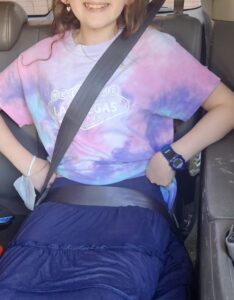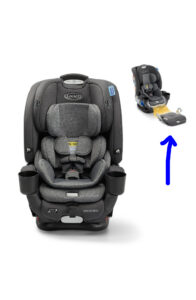IIHS Rear Seat Minivan Testing – Help! My car failed!

![]()
![]()
![]()
![]()
![]()
Many parents and caregivers are understandably very concerned at the new IIHS minivan rear seat test results that were released two days ago. These tests show that four popular minivans, the Honda Odyssey, the Toyota Sienna, the Chrysler Pacifica and the Kia Carnival, fail to adequately protect a 12-year old sized dummy in the back seat.
The video certainly looks horrifying, as we can see the dummy thrown around the back. In the Odyssey, the headrest even flings off. (That is horrifying – come on, Honda.)
But before we panic, let’s break down exactly what’s happening here.
The Age of the Dummy
The dummy used for the testing is the equivalent of a 12-year old child or very small adult woman. Now, you may be thinking, “haven’t I read some articles that say that this age child can still be in a booster if needed”? The answer is yes. You have.
In the test videos, it seemed (especially in the Sienna) that the dummy may have benefited from a no-back booster. A no-back booster will raise the child to be the optimal height for the side airbag (which notably did not deploy in the Sienna), it put the lap belt in a position designed to prevent submarining, which occurred in the Sienna, and it will keep the shoulder belt off of the neck.

She’s almost 12, but the shoulder belt is hovering and the lap belt is high. She still needs a booster.
So you may be thinking, why didn’t the IIHS test with a no back booster, then? Maybe try it with and without? Don’t they advocate for booster use, as we do? They absolutely do. But, this leads us to…
How should you respond to this if you are an automobile manufacturer?
Here’s the issue, auto manufacturers: IIHS is likely testing this way because virtually no one is putting their 12 year old kid in a booster. We wish they would, if the kid needs it, but they’re not. And if they are, they’re certainly not providing a booster for their 4’11” grandmother or their petite friend or the shortest guy on the high school football team who is also riding in the back. (My own grandmother was this height, so I know from whence I speak.) In fact, aside from special needs seats, no generally sold booster even exists for adults. That’s why the seat geometry and seatbelt geometry needs to change.

The above photo subject a little bit older in a different car. Now she passes the 5 step test – in this vehicle.
“Seat geometry” and “seatbelt geometry” are broad terms which encompass many factors relating to how the belt fits the seat’s occupant. Does it come out high on the wall? Does the captain’s chair look like your living room armchair or like your sagging leather couch? Is the seat back adjustable? Is the buckle at your hip or almost behind your back? These are some of the variables that will need be studied and change for cars to score better on these tests and keep their rear occupants safer.
How should you respond to this if you are a parent, caregiver or anyone who may drive a child?
So, given the above: please be absolutely, 100% certain your child doesn’t need a booster before you take it away. Review the rules for the five step test. Try this in each car your child will be in, including friends’ cars.
Your reaction to this video may be to want to move your child to the front seat. DO NOT move your child into the front seat too early. The minimum recommended age for the front seat is 13-years and when the belt fits correctly. Remember, the front seat is not designed to fit a 13-year old unless they’re the size of an average adult. A child may “5 step” in the back but not come anywhere close to fitting correctly in the front and the results could be even worse in a crash.
As stated clearly in the video, the recommendations for when to use rear and forward facing car seats don’t change in the slightest.

Our same photo subject, feeling a bit camera shy this time, in the third row of a Honda Odyssey. Note the completely different lap belt fit.
If you’re a smaller adult, or if one regularly rides in your car, try to find the best fitting seating position for this person. The back middle is going to fit very differently than the third row side which will fit differently than a captain’s chair. Don’t be afraid to try a few of them.
How should you respond to this if you are a car seat and booster manufacturer?
This one is simple. Car seat manufacturers need to make boosters available for preteens and advertise them as such. The Safety 1st incognito was a fabulous choice – but it was discontinued. The latest entry into the market is the Graco Rightguide, which starts at 50 lbs and may or may not be discontinued depending on who you ask at Graco. But, it is definitely found as part of the new Graco 4Ever DLX Grad 5-in-1 that costs over $300. My point here is – since Graco is still manufacturing this product to insert it into their new seat, could they not continue to sell it separately?

The new Graco 5 in 1 seat. I spy the Rightguide booster!
Aside from Graco, there is no other manufacturer with a booster designed for or marketed to the older booster riders. This is a huge problem. Now would be the perfect time for the manufacturers to develop such a product and introduce it on the heels of this study.
How about an adult booster? We have been asked countless times about what an adult with a poor fitting belt should do. There’s no perfect solution – but a solution is needed for shorter adults who may not fit in a booster meant for children or who may be over the weight limit for one. Unlike kids, Adults should be reasonable enough that they would not compromise a poorly fitting shoulder belt by moving it behind their arm or back, leaving them with no upper body restraint. Even so, a poorly fitting seatbelt will still leave them at greater risk in a crash than a correctly fitting one.
In conclusion…
We commend the IIHS for this important study, and we hope that it will push auto manufacturers, booster manufacturers and parents and caregivers to respond appropriately. Seatbelts and seats that better fit smaller occupants are crucial for protecting these passengers in the back seat.







